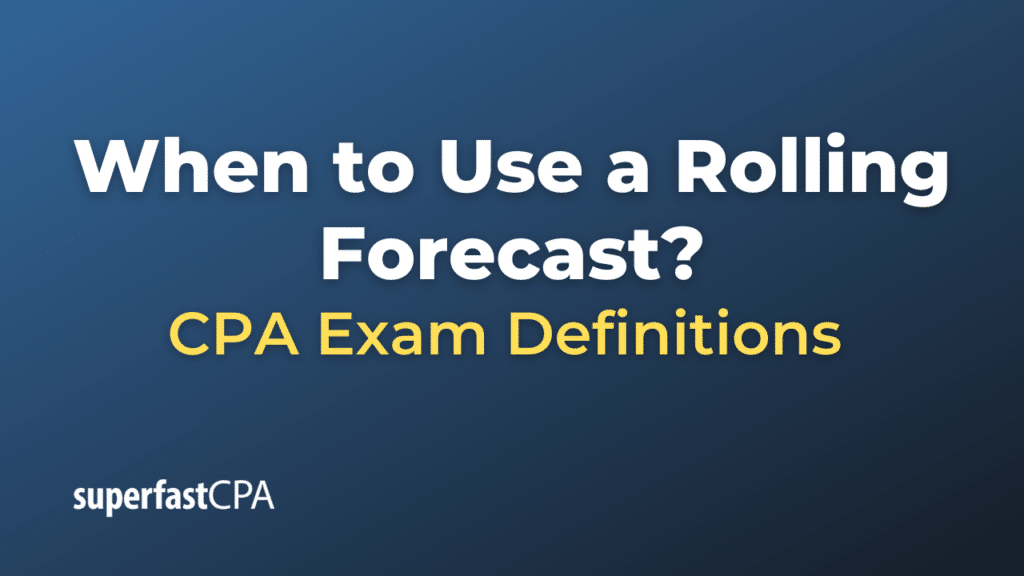When to Use a Rolling Forecast
A rolling forecast is an approach to planning and budgeting that involves continuously updating projections for a set period (e.g., 12 months) into the future as new data becomes available. This approach is different from the traditional static budgeting process, which sets fixed targets for an entire fiscal year and often does not adapt as circumstances change. Rolling forecasts can be beneficial under certain circumstances, but they may not be appropriate for all organizations or scenarios.
When to Use a Rolling Forecast:
- High Volatility: Businesses operating in volatile environments, like commodities or technology sectors, can benefit from rolling forecasts, as they allow for quick adjustments to strategies and budgets.
- Rapid Growth: Companies experiencing rapid growth often face unpredictable changes. A rolling forecast can offer more agility in planning and resource allocation in such situations.
- Economic Uncertainty: During periods of economic uncertainty, static budgets may quickly become obsolete. Rolling forecasts can adapt to changing conditions.
- New Business: For startups or new business divisions, there may be little historical data to rely on for planning. Rolling forecasts can be more suitable in such cases.
- Seasonal Variability: Businesses with high seasonal variability might find rolling forecasts useful for managing inventory, cash flow, and labor requirements more dynamically.
- Complex Projects: For companies managing large or complex projects that span multiple years, a rolling forecast can provide ongoing visibility into project financials.
- Competitive Markets: In highly competitive markets where consumer preferences can change quickly, rolling forecasts can be a better tool to adapt and stay ahead.
- Operational Complexity: Businesses with complicated supply chains, production cycles, or service delivery mechanisms might find rolling forecasts useful for detailed, short-term planning.
- Regulatory Changes: Industries that are subject to frequent regulatory changes can benefit from the flexibility offered by rolling forecasts.
Example of When to Use a Rolling Forecast
Let’s continue with the example of “TechWave,” a technology startup working on a new smartphone, to illustrate how rolling forecasts can be used effectively.
Context:
- TechWave initially prepared a static annual budget in January with estimated revenues of $20 million and expenses of $15 million for the year.
- In June, a new competitor enters the market, offering a similar product at a significantly lower price.
- TechWave decides to switch from a static annual budget to a 12-month rolling forecast, updated monthly.
Rolling Forecast Process:
Step 1: Initial Forecast
In July, TechWave creates its first rolling forecast, covering the period from July this year to June of the following year. Given the new competition, they now project:
- Revenues: $18 million (down from an initial estimate of $20 million)
- Expenses: $16 million (up from an initial estimate of $15 million due to increased marketing spend)
Step 2: Monthly Update – August
In August, TechWave receives data showing actual revenues and expenses for July and updates its rolling forecast accordingly. The forecast now covers August this year to July next year.
- Actual July Revenues: $1.2 million (below forecast)
- Actual July Expenses: $1.4 million (above forecast)
The new rolling forecast adjusts future months based on these real-world results.
Step 3: Strategic Adjustments
Due to the lower-than-expected July performance, TechWave decides to:
- Accelerate the development of a more advanced model.
- Launch a promotional campaign to boost sales.
This decision increases projected R&D and marketing expenses but is expected to result in higher future revenues.
Accounting and Management Implications:
- Monthly Forecast Updates: Every month, TechWave will adjust its forecast to roll over to the next month, adding a new month at the end and dropping the oldest month.For example: When September starts, the forecast will cover September this year to August next year.
- Resource Reallocation: The monthly forecast updates help TechWave make quick resource allocation decisions, like shifting funds to R&D or marketing.
- Performance Monitoring: By comparing the rolling forecast against actual results each month, TechWave can identify performance gaps and take corrective action more rapidly than with a static annual budget.
By adopting a rolling forecast, TechWave can remain agile, adapting to market changes and realigning its strategy on an ongoing basis. This is crucial for a startup operating in a volatile market, allowing them to optimize decision-making and improve their competitive positioning.













